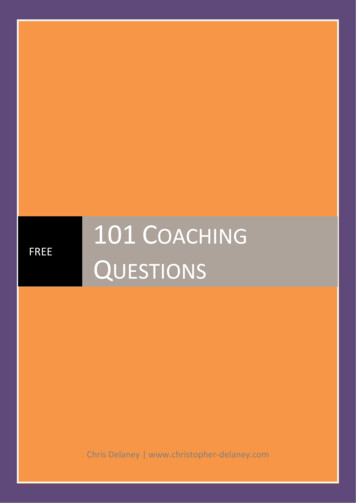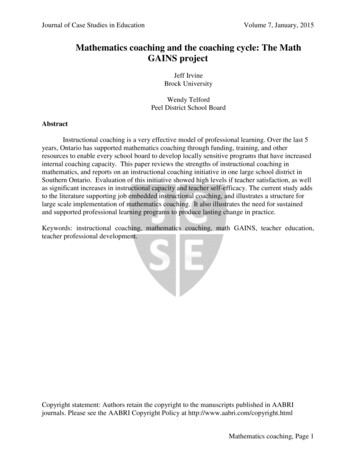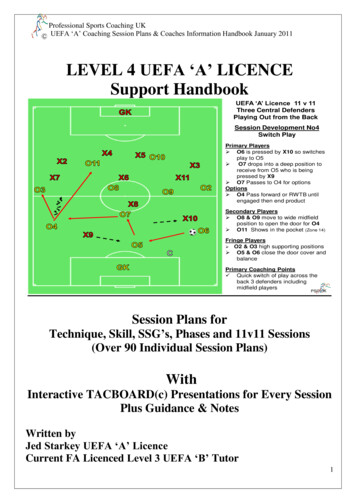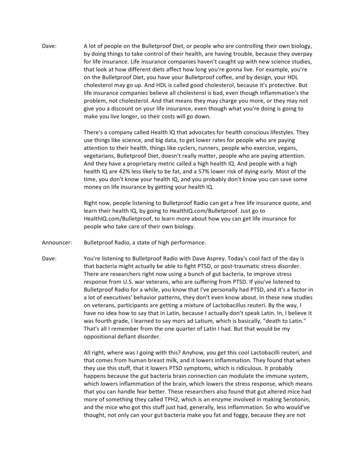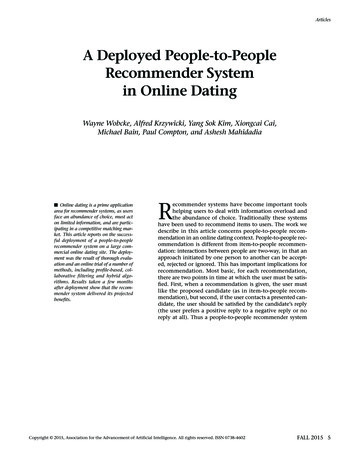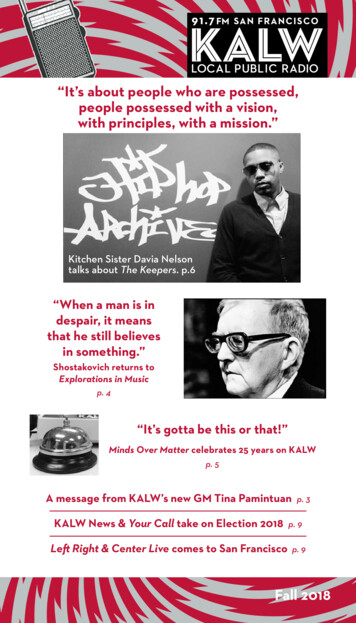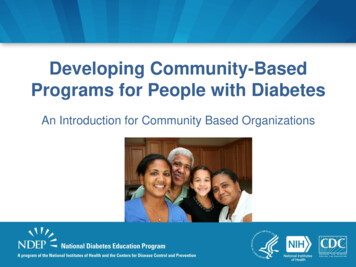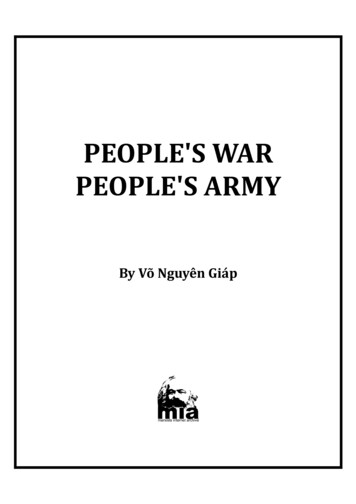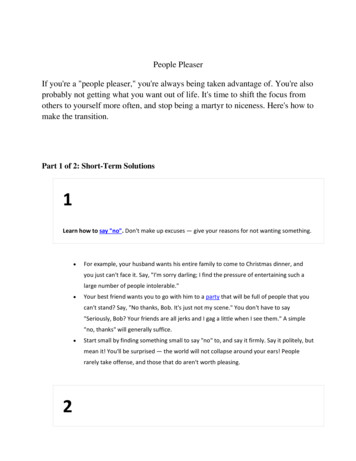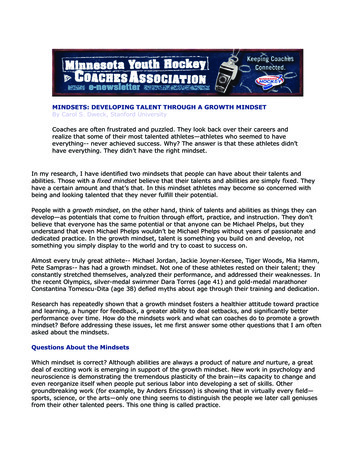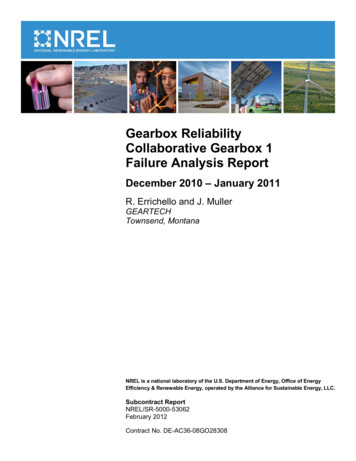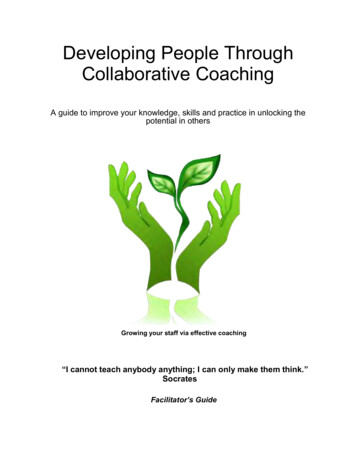
Transcription
Developing People ThroughCollaborative CoachingA guide to improve your knowledge, skills and practice in unlocking thepotential in othersGrowing your staff via effective coaching“I cannot teach anybody anything; I can only make them think.”SocratesFacilitator’s Guide
Developing People Through Collaborative CoachingContentsWorkbookCoaching as Mentoring . 3Pre-Class Survey . 3Trust Walk . 4Different Perspectives . 4Bad-to-Good Coaching Questions. 5Where Do We Want to Go? . 5TGROW Model of Coaching. 6Agreeing to SMART Objectives. 7Origami Gemba. 8Active Listening Self-Assessment . 8Travel Agency . 9Shaping Up . 10Effective Delegation . 11Self-Assessment of Your Coaching Skills . 12Reference Book1. What is Coaching? . 132. Collaborative Coaching . 143. The Importance of Questions . 164. Ten Great Coaching Questions . 185. TGROW Model of Coaching. 196. Agreeing “SMART” objectives . 227. Walking the Gemba . 248. Active Listening. 269. The Art of Feedback . 2810. Guidelines for Effective Delegation . 3211. Resources . 35Page 2
Developing People Through Collaborative CoachingOpening Ice Breaker: Coaching as MentoringBefore class begins, divide participants into groups of three or four. Have them take turnsanswering the following questions, and encourage them to act as interviewers to draw out theanswers: What do you know now that you wish you knew early in your career? What differencewould it have made? How could a coach help you now? What lessons have you learned about working at DHS that you might pass on tosomeone else as his or her mentor?Using the information above, lead a discussion about how coaches can help employees, andhow these ideas can help build effective coaches.Questions for discussion:1. What does coaching mean to you?2. Who was the best coach you ever had? Why?3. What quality made that person a great coach?4. How do you use that quality when leading your team?Pre-Class SurveyInstruct participants complete this survey at their seats, located in participant workbook:Does your supervisor:1. Frequently ask for your opinion?Completely disagreeDisagreeNeutralAgreeCompletely agreeNeutralAgreeCompletely agreeDisagreeNeutralAgreeCompletely agreeDisagreeNeutralAgreeCompletely agree2. Listen to your suggestions?Completely disagreeDisagree3. Take your ideas seriously?Completely disagree4. Value your opinion?Completely disagree5. Check with you before making a decision that affects your work?Completely disagreeDisagreeNeutralAgreeCompletely agree6. Seem as though he/she would defend you in a meeting of supervisors?Completely disagreeDisagreeNeutralAgreeCompletely agree7. Explain goals clearly when giving you a new project?Completely disagreePage 3DisagreeNeutralAgreeCompletely agree
Developing People Through Collaborative Coaching8. Welcome your questions about an ongoing project?Completely disagreeDisagreeNeutralAgreeCompletely agree9. Give you latitude in deciding how to carry out a project?Completely disagreeDisagreeNeutralAgreeCompletely agreeAgreeCompletely agree10. Save criticism for one-on-one sessions?Completely disagreeDisagreeNeutralWhat is Coaching? Trust WalkDivide participants into pairs. Ask one person to volunteer to close their eyes so they can beguided on a sightless tour around the training facility. They can walk wherever they like, butemphasize that sighted people are responsible for the safety of their sightless partners. Sightedpartners are allowed only to verbally guide their partners — touching is not allowed at all. Theyhave five minutes to walk, after which time they switch their sightless/guide roles.Have each pair identify three ways to build trust. Have them share these ways with their tablesand complete the Questions for Discussions.Questions for Discussion:1. When you first started your walk, how much did you trust your partner to guide yousafely? How strong was the urge to open your eyes?2. What did your sighted partner do that increased your level of trust?3. What did your sighted partner do that decreased your level of trust?4. When you were guiding your sightless partner, to what extent did you consider howmuch they trusted you to guide them?5. Did you purposely take any actions to increase their trust in you?6. If you did, do you think your actions were effective? Why?Collaborative Coaching: Different PerspectivesDivide the class into four groups and assign each team the task of answering questionsthat are asked about the SNAP Emergency Services process from their given perspective.Then have the groups report out their answers. If at all possible, make sure that employeesare in groups that do not contain their role at DHS.Group 1 will answer questions related to the Agency. How does Expedited Services support the mission and goals of DHS? How does Expedited Services impact the SNAP program? Why is Expedited Services necessary?Group 2 will answer questions related to the County Director. How is my office doing on Expedited Services? What skills do my supervisors need to assist their staff with successfully meetingEmergency Services standards? What is my office’s motivation for doing work? Why is Expedited Services necessary?Page 4
Developing People Through Collaborative CoachingGroup 3 will answer questions related to the Supervisor. What skills or knowledge does my team need to successfully meet EmergencyServices Standards? What is my motivation? Why is Expedited Services necessary?Group 4 will answer questions related to the Customer. What am I here to receive? How does Expedited Services benefit me? What do I perceive as quality service? How does DHS show that it cares about Oklahomans?Questions for discussion:1. When coaching, which perspectives do you need to keep in mind?2. Why are other people’s perspectives important?3. What is important for managers to remember as they coach their employees?4. How would a more collaborative style of coaching help bridge the gaps between thedifferent perspectives in our agency?The Importance of Questions: Bad-to-Good Coaching QuestionsDivide participants into pairs and have them change the list of not-so-great questions into onesthat can be used in an effective coaching session:1. Why are you behind schedule?2. What’s the problem with this project?3. Did you make your sales goal?4. When can I expect to have this report from you?5. Why did you fail to complete this project?6. Whose fault is it that we did not meet our timeliness goal this month?7. Why can’t you all work together?8. How far are you with this case? Can you finish it by 4 p.m. today?9. Did you like this training?10. How is everything going?Review answers with participants and then answer the questions for discussion.Questions for discussion:1. What were some of the things that made the original list not so great? What did youdo to correct them?2. What is important to keep in mind when formulating a question?3. How do questions play a role in Collaborative Coaching?Where do we want to go? (Precursor to TGROW Model)Have participants think about and write down three changes in their office that woulddramatically improve customer service and productivity. In addition, they should note two otherfactors that are needed to make those changes.Example:Page 5
Developing People Through Collaborative Coaching1. Less wait time for clients in waiting rooma. Clerical staff knowledge of county office practices.b. Programs staff seeing clients in timely manner.Have participants share their answers and then complete the questions for discussion:Questions for discussion:1. How much control do you have over the likelihood that the desired changes will takeplace?2. What is your role in ensuring these changes happen?3. How could coaching play a role in making these changes?4. How helpful would it be to have a vision statement that describes the future state of yourcounty office?The TGROW Model of CoachingHave participants break up into groups of four or five, with at least two people agreeing to playthe employee. Have each group read one scenario and answer the following questions. Theyshould also come up with at least one question for each section designed to assist their staffmember with developing goals and moving forward.1. Identify the issue. (Topic)2. What is the desired outcome? (Goals)3. Discuss what is currently happening. (Reality)4. What options can be offered? (Options)5. What will you do to foster a change in behavior? (Way forward)Subject: KarenKaren has been a SNAP supervisor for almost three years. Overall, her performance is verygood, and her team’s error and timeliness rates stay above the acceptable limit. By nature, sheis a perfectionist and wants to approve only those cases that are perfect and error-free. In fact,Karen has become a bottleneck for her team. This lack of time management affects otheraspects of her work such as assisting staff, returning phone calls in a timely manner, andcompleting other administrative work.Subject: LarryLarry has worked for the SNAP program for over 20 years, and he understands and adheres toDHS policies very well. However, Larry is having difficulty performing new duties associatedwith AFS’ new Collaborative Coaching initiative. He feels that his duties as a supervisor are fineas they are, and if his group is performing to standards, then there is no need to coach them.Subject: AliceAlice has worked in AFS for eight years. During this time, she has always volunteered for extraduties, received great feedback, and was promoted to supervisor. As the county director, youhave received information that a county director is retiring in your region. Alice would be aperfect candidate, and it would provide a nice stepping-stone to prepare her for largerleadership roles in AFS. However, there are a few skills she needs to gain in the delegation andleadership arenas before she will truly be ready to apply for this position.Page 6
Developing People Through Collaborative CoachingSubject: DaltonDalton is a supervisor that has bought into the concept of Collaborative Coaching and tries tocoach his staff on a weekly basis. However, he has conflicts with a few members of his teamand, as a consequence, he does not coach them as much as the others. You are aware of this,and Dalton excused this behavior by saying those employees are performing well and do notneed as much assistance as the others. You agree with this, but still want all employees to bedeveloped.Subject: CarolCarol is an excellent employee in your office who consistently exceeds expectations fortimeliness and accuracy. Your office has recently developed new SOPs standards that veryspecifically state that all cases must be completed in the interview room. Her supervisor does aGemba Walk and notices that Carol takes her casework back to her desk and finishes her workthere. When asked why, she stated that she can complete the case faster, and moving to herdesk frees up an interview room for someone else to use, which is needed due to the shortageof interview rooms at this particular office. Your supervisor has requested assistance in sortingout this issue with Carol and you are stepping in to help.Questions for discussion:1. Were all of the answers the same or different? Why?2. What is the difference between Alice’s issue and all the others?3. What are some questions we can begin asking in each of these scenarios to learnmore information?Agreeing on SMART ObjectivesHave the participants break up into the same groups that were used for the TGROW Model ofCoaching exercise. They should also use the same scenarios, roles and TGROW answers toinform the development of SMART Objectives for the subjects. Participants will set objectives bycompleting each section of the SMART acronym.Specific: What is the exact outcome that is to be accomplished? The statement should containboth an action verb and an object.Measurable: How will you verify that progress and/or success is achieved? Use quantifiableterms where possible.Achievable: Does the employee possess the necessary skill and knowledge to reach theobjective? Do they have sufficient motivation and the resources?Relevant: Does this objective have real benefits for the organization? It could also be adevelopmental benefit for the employee to prepare her for a more advanced role.Time Constrained: What are the dates for milestones, deadlines, etc.? If there is no deadline, astatement such as “at all times” or “in accordance with laid down procedures” should be used.Full SMART Objective:Page 7
Developing People Through Collaborative CoachingQuestions for discussion:1. At what point in the TGROW model are SMART objectives developed?2. What was the most difficult part of developing the objective?3. What are the next steps you would take to help the employee reach a goal?Walking the Gemba: Origami GembaDivide participants into groups of three: one pair and an observer. Give one person in the pair aFrog instruction sheet and the other person a Boat instruction sheet.Tell the groups that the person with the Frog sheet will be the Coach and instruct the Folder,who has received the boat sheet, on how to create the frog. The Observer will be given theCoaching Gemba worksheet. Physically split up the group and allow 15 minutes for the practiceof origami. During this time, the Observers should complete the preparation section of theGemba worksheet. Facilitators may assist the coaches and observers with the process so theyget as proficient as possible.Put the pairs back together and allow 10 minutes for Coaches to instruct the Folders on how tocreate a frog. The Coach should try to incorporate as much material from today’s training aspossible into their instruction session. Instructions can be verbal only. The Coaches are notallowed to use any visual aids such as the instruction sheet, hand gestures, or touching thepaper or Folder. During this time, allow the Observers to take notes but they are not allowed totalk or interact with the pair at all. Once the 10 minutes is over, allow time for role-playing. Havethe Observer answer the following questions. What did you observe?What types of questions could you ask about the coaching session to gainunderstanding, build confidence, and encourage solution thinking?What could your next steps be?Questions for discussion:1. In order to effectively do a Gemba Walk on coaching, how important is it to understandwhat is being coached?2. How did this exercise speak to the need for preparation prior to going on a GembaWalk?3. How could the Observers begin coaching the Coaches based on what they saw? Whatare some of the next steps the Observers can take?Active Listening Self-Assessment (Precursor to Active Listening)Instruct participants to complete this self-assessment at their seats and then rate themselves onhow adept they are at the three aspects of active listening listed below.ALWAYSWhen another person is speaking to me, I.1.Make eye contact with the person.2.Think of different perspectives I have on the sametopic.Page 8MOST OFTHE TIMESOMETIMESRARELYNEVER
Developing People Through Collaborative CoachingALWAYS3.Rephrase the comments and ideas back to the otherperson.4.Try to anticipate what the person will say next.5.Pay attention to his or her facial expressions, handgestures, posture and other physical cues.6.Think about issues not related to the conversation.7.Think about what I am going to say next.8.Interrupt to make a point or comment.9.Prepare a response to a prior comment.10.Smile, nod or give other physical cues in response.11.Ask follow-up or probing questions to gain clarity orget more information.12.Immediately react emotionally to the message.MOST OFTHE TIMESOMETIMESRARELYNEVERThe results of this assessment can help direct and focus your efforts to improve your listeningskills. This assessment considers how adept you are at three aspects of active listening: focus,feedback and filtering. Focus: Being attentive to the speaker and the message he or she is trying to convey. Feedback: Completing the communication cycle by encouraging the speaker, askingclarifying questions, paraphrasing statements and summarizing key points. Filtering: Creating personal meaning from the speaker’s comments. Putting the speaker’scomments in context with your own experiences, knowledge and perceptions.If you scored yourself more toward the “Always” column on questions 6, 7 and 9, or toward the“Never” column on questions 1 and 5, you may need to work on your focus when listening toothers.If you scored yourself more toward the “Always” column on question 8 or toward the “Never”column on questions 3, 10 and 11, you may need to work on how effectively you providefeedback when listening to others.If you scored yourself more toward the “Always” column on questions 2, 4 and 12, you mayneed to work on how you filter information when listening to others.Page 9
Developing People Through Collaborative CoachingActive Listening: Travel AgencyDivide the participants into pairs, one Customer and one Travel Agent. They are going toplay a game called “travel agent” and it will take place in two rounds. The Customers are instructed to speak about their lifestyles and ideals for avacation destination without naming any place. Conversations last about fiveminutes. The Travel Agents must listen closely, because after the conversation theywill have two minutes to put together a vacation package including travel, ahotel and a few activities. The Customers then give feedback to the Travel Agents on their vacationideas. For Round 2, the Customers and Travel Agents swap places and repeat thisexercise.Questions for discussion:Travel Agents:1. Did you find it easy or difficult to listen? Why?2. What techniques did you employ to listen attentively and show that you are followingthe conversation?Customers:1. What techniques were most effective in showing that the Travel Agent cared?2. Were you happy with the recommendations you received from the Travel Agent afterexplaining your situation?Facilitator: Was there a pattern in misunderstandings and, if yes, what caused them?The Art of Feedback: Shaping UpDivide the group into pairs — Supervisors who give instructions and Employees who followinstructions. This exercise is played in two rounds. Participants sit with their backs to eachother. All the Supervisors in this training game are given a figure on a paper, seen at theright.Round 1:The Employees are given an empty sheet of paper and a pen or pencil. TheSupervisors are expected to communicate the figure to their Employees sothat the Employees are able to draw an exact replica.In the first round, a constraint is introduced. The Employees are told not tospeak while playing this round of the training game. They can only listen anddraw according to the instructions by Supervisors.After everybody has finished playing the round, the Employees share theirversion of the figure with the Supervisors.Round 2:In this round, the Supervisors are given a second figure. This timethe Employees are given the opportunity to speak and check withPage 10Round 2Round 1
Developing People Through Collaborative Coachingthe Supervisors about any instructions that they did not understand. After they havefinished, the Employees show their figures.After the pairs review the second work, do the questions for discussion.Questions for discussion:1. Which round was easier? Why?2. How did the feedback improve from the first round to the second round? Why was itmore helpful?3. How was the second round’s feedback more FAST than the first round? Frequent Accurate Specific TimelyGuidelines for Effective DelegationInstruct participants to divide into groups of five. One participant is the supervisor and theothers are employees. For this exercise, participants are asked to make 15 airplanes in fiveminutes. The exercise is played in two rounds.Round1:Supervisors will leave the tables to go learn how to create paper airplanes. Once they’vemastered this work, they then join their group. The supervisors then decide, on their own,the following items: Roles How tasks associated with creating a paper airplane are assigned, ensuring thatworkload is distributed evenly How resources will be distributedOnce the team begins the work, the supervisor’s job is to oversee them, which includesclarifying work and coaching as needed.Round 2:The supervisor now works with the team to establish a plan for getting the work done. Theywill evaluate their process collaboratively by praising what went well and redirecting whatcould have been done better. During this time, the supervisor should coach the team, offerconstructive feedback, and encourage solution thinking. The team works on the airplanesagain, this time with their new roles and resource plans.Questions for discussion:1. Supervisors: Which was easier — the first round or second round?2. How did Supervisors decide on your method of delegation? Was there a reason thatcertain tasks were assigned to certain people?3. How did the group decide on the delegation plan?4. Was the following covered? Target Clarity on how to make the airplanes Did everyone feel responsible? Did everyone understand how his or her role fit into the larger picture, orwere people simply assigned specific tasks?Page 11
Developing People Through Collaborative Coaching5. What are some tasks that can be delegated in your offices?6. What are the elements of good delegation?Self-Assessment of Your Coaching SkillsOnce the class is over, participants will take this self-assessment with the knowledgethey’ve received from the class. Participants will answer questions on a scale of 1 to 5 with5 being “Completely Agree.”1. I already possess the skills and knowledge I need to be an effective coach.Completely disagreeDisagreeNeutralAgreeCompletely agree2. I use delegation as a means of developing others’ skills.Completely disagreeDisagreeNeutralAgreeCompletely agreeNeutralAgreeCompletely agreeNeutralAgreeCompletely agree3. I set clear goals for staff as targets.Completely disagreeDisagree4. I give specific and timely feedback.Completely disagreeDisagree5. I feel I have resources available to me to assist with coaching my employees.Completely disagreeDisagreeNeutralAgreeCompletely agreeAgreeCompletely agreeNeutralAgreeCompletely agreeNeutralAgreeCompletely agree6. I know how to prepare my employees for coaching.Completely disagreeDisagreeNeutral7. I observe my employees’ work and behavior.Completely disagreeDisagree8. I tend to ask open-ended questions.Completely disagreeDisagree9. I work with employees to reach agreement on desired goals and outcomes.Completely disagreeDisagreeNeutralAgreeCompletely agree10. I can separate observations from judgments or assumptions.Completely disagreeDisagreeNeutralAgreeCompletely agreeQuestions for discussion:1. What are your strengths? Weaknesses?2. If you do need assistance with Collaborative Coaching, where can you turn?Page 12
Developing People Through Collaborative Coaching3. What are some other resources you have available to you to help with CollaborativeCoaching?4. How can you get started?What is Coaching?Coaching is a cost-effective, efficient way of supporting employee development and growth.Unlike a training course, coaching is flexible in its timing and an integral part of the day,providing exactly what is wanted, where and when it is wanted. At its best, it is a partnershipwhere both sides gain satisfaction. For this to work, both parties need to be motivated toparticipate in the coaching process by being open and trusting, as well as by setting theground rules for coaching to take place.A good definition of coaching is “the art or science of someone helping another reach highereffectiveness by creating a dialogue that leads to self-awareness and action.” Other views aboutcoaching are listed below. How similar or different is your definition from those in this list?“Coaching is not giving advice or giving solutions. It is about helping the other person find his orher own solution.”“Coaching is a cyclical process of enhancing the other person’s awareness of 'what is reallygoing on,' guiding them to choose responsibility for the actions they will take to achieve theirpersonal goals and helping them to evaluate the consequences.”“You can get the best efforts from others not by lighting a fire beneath them, but by building afire within them.”“A very important factor in coaching is to define personal goals and intended actions required toachieve those goals”“The effects of good coaching are reciprocal. Effective coaching helps managers and leaders toexperience the satisfaction of seeing others grow and develop and perform at their best.”“Coaching is gaining acceptance and recognition as an emerging profession because it works.While individual coaching continues to be important for personal and professional development,team coaching is increasingly utilized within organizations. Coaching with teams creates theopportunity for broader organizational impact and performance.”Page 13
Developing People Through Collaborative CoachingCollaborative CoachingCollaborative Coaching is a vehicle for the continuous growth, encouragement anddevelopment of AFS employees. It focuses on the relationship between thesupervisor and employee, and fosters open dialogue and the exchange ofinformation.Purposes of a coaching conversation To focus attention on key issues affecting performance of employees To develop employee skills and prepare them for greater responsibility To focus on the detail and content of the conversation as it relates tothe key issues To promote personal responsibility for the problems or resolve issues they identifyas part of the coaching conversation To encourage supervisor-employee cooperation, to discover what obstacles stand inthe way of success, and what both can do to help remove them To create a positive feedback loop between the supervisor and team memberthrough listening and engaging To disseminate information at the unit, office, division and agency levelsSupervisors possess greater experience and program knowledge than their subordinates, whichmeans that they are able see more potential solutions or alternatives to issues than employeesoften do. The urge to give people the correct answer might be strong, but most employees findmore motivation to perform if they come to their own conclusion that development is necessary.In addition, one theory of business management suggests that employees behave the way theydo because they pick the best alternatives from their pool in a given situation. CollaborativeCoaching allows supervisors to provide the tools and situations to accelerate how quicklyemployees accumulate additional choices and aims to help the coached discover answers forthemselves rather than accept those forced upon them.Page 14
Developing People Through Collaborative CoachingCollaborative Coaching is not only about fixing what is wrong with performance, it is also aboutrecognizing what folks do correctly and building on their strengths. One study found thatmanagers recognize their employees less than one-fourth of the time that they makeachievements, despite recognition and achievement being powerful motivators for employees toperform higher. Additionally, since Collaborative Coaching is about deeper relationships,supervisors learn more about employees’ natural interests and inclinations, and can use thisinformation to help employees further grow.Collaborative Coaching can also act as a vehicle for distributing information and gainingfeedback. As supervisors coach their employees at all levels, information will be able to travel ina top-down and bottom-up fashion. This will result in a decreased gap between the state officeand fie
Self-Assessment of Your Coaching Skills 12. Reference Book . 1. What is Coaching? 13 2. Collaborative Coaching 14 3. The Importance of Questions 16 4. Ten Great Coaching Questions 18 5. TGROW Model of Coaching 19 6. Agreeing “SMART” objectives 22 7. Walking the Gemba 24 8. Active List
